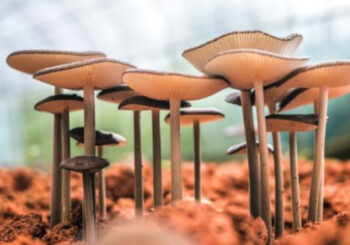By John Patterson
Staff Writer for Wake Up World
In a ground breaking study conducted by researchers at RMIT University, the potential of mycelium, an incredible network of fungal strands, has been unveiled as a highly promising and innovative solution for sustainable fireproofing. By employing chemical manipulation techniques to alter its composition, scientists are actively exploring the remarkable fire-retardant properties exhibited by mycelium.
This breakthrough discovery has the potential to revolutionize the construction industry, offering a glimmer of hope in preventing tragic incidents akin to the devastating Grenfell Tower fire. The profound implications of this study transcend traditional fireproofing methods, introducing mycelium as a renewable and environmentally friendly alternative to conventional cladding materials.
With its vast range of applications, mycelium has emerged as a beacon of sustainability, promising a brighter future for fire safety in the architectural landscape.
Mycelium: Unveiling Its Hidden Potential
Mycelium, typically found in composite form mixed with residual feed material, has been successfully grown as pure mycelium sheets through the research efforts led by Associate Professor Tien Huynh, an expert in biotechnology and mycology. Huynh explains, “We found a way to grow pure mycelium sheets that can be layered and engineered into different uses—from flat panels for the building industry to a leather-like material for the fashion industry.”
The innovative technique employed in this study involves creating paper-thin mycelium sheets, akin to wallpaper, without compromising the integrity of the fungal filament network. By employing specific growth conditions and chemicals, the researchers achieved a thin, uniform, and crucially, fire-resistant material.
Fungi Fireproofing: Protecting Our Buildings
The primary focus of the researchers is the development of bio-derived, fire-retardant cladding for buildings. Associate Professor Everson Kandare, an expert in flammability and thermal properties of biomaterials and co-author of the study, highlights the potential of mycelium as a fireproofing material. “The great thing about mycelium is that it forms a thermal protective char layer when exposed to fire or radiant heat,” states Kandare. “The longer and the higher temperature at which mycelium char survives, the better its use as a fireproof material.”
In contrast to traditional cladding materials, mycelium-based cladding can be produced from renewable organic waste and is environmentally benign when burned. Kandare emphasizes the harmful effects of commonly used fire retardants containing bromide, iodide, phosphorus, and nitrogen, which produce toxic fumes and pose health and environmental risks. In contrast, mycelium produces naturally occurring water and carbon dioxide, making it a sustainable and safe alternative.
Collaboration and Future Prospects
While mycelium offers immense potential, there are challenges to overcome, particularly in terms of scalability and production efficiency. Huynh notes, “Plastics are quick and easy to produce, whereas fungi are slow to grow and relatively harder to produce at scale.” However, an exciting collaboration is on the horizon as the researchers have been approached by the mushroom industry, presenting an opportunity to utilize fungal-incorporated waste products. By collaborating with the mushroom industry, the need for new farms can be eliminated, and fire safety requirements can be met sustainably.
Looking ahead, the researchers aim to develop fungal mats reinforced with engineering fibers to enhance fire safety measures. These mats are expected to delay ignition, reduce flaming intensity, and improve fire safety rankings—an important step toward creating enhanced and eco-friendly cladding materials for buildings.
Conclusion
The discovery of mycelium’s fire-retardant properties opens up a realm of possibilities for sustainable fireproofing in various industries. By harnessing the power of this natural material, we can move away from harmful fire retardants and embrace eco-friendly alternatives. With ongoing research and collaboration, the vision of bio-derived, fire-resistant cladding materials may soon become a reality. Mycelium, with its ability to thrive on organic waste and its remarkable fire-retardant properties, presents a promising pathway towards a safer and more sustainable future.
Reference:
- Nattanan Chulikavit, Cheng Wang, Tien Huynh, Anthony Chun Yin Yuen, Akbar Khatibi, Everson Kandare. Fireproofing flammable composites using mycelium: Investigating the effect of deacetylation on the thermal stability and fire reaction properties of mycelium. Polymer Degradation and Stability, 2023; 215: 110419 DOI: 10.1016/j.polymdegradstab.2023.110419
About the author:
John Patterson is an avid writer and researcher who delves into the latest scientific research. With an insatiable curiosity, he translates complex concepts into accessible narratives, allowing readers to embark on a journey of discovery. Through his work, John bridges the gap between experts and the public, igniting curiosity and inspiring meaningful conversations about scientific breakthroughs.

If you've ever found value in our articles, we'd greatly appreciate your support by purchasing Mindful Meditation Techniques for Kids - A Practical Guide for Adults to Empower Kids with the Gift of Inner Peace and Resilience for Life.
In the spirit of mindfulness, we encourage you to choose the paperback version. Delve into its pages away from screen glare and notifications, allowing yourself to fully immerse in the transformative practices within. The physical book enriches the learning process and serves as a tangible commitment to mindfulness, easily shared among family and friends.
Over the past few years, Wake Up World has faced significant online censorship, impacting our financial ability to stay online. Instead of soliciting donations, we're exploring win-win solutions with our readers to remain financially viable. Moving into book publishing, we hope to secure ongoing funds to continue our mission. With over 8,500 articles published in the past 13 years, we are committed to keeping our content free and accessible to everyone, without resorting to a paywall.







